

Damion Smy
Chevrolet Corvette Grand Sport could get 6.7-litre LS6 V8 - report
11 Hours Ago
Angus MacKenzie hits the famed Silverstone GP circuit in Porsche's latest track monster – the 992-series 911 GT3 RS.



Quickly see how this car stacks up against its competition. Select any benchmark to see more details.
Where expert car reviews meet expert car buying – CarExpert gives you trusted advice, personalised service and real savings on your next new car.
RS. It means RennSport – ‘racing sport’ in German.
Those initials first appeared on a Porsche 911 50 years ago; the legendary Carrera RS 2.7, a homologation special developed to allow Porsche to enter the 911 in Group 4 GT racing. Since then, they’ve come to designate only the most driver-focused 911s in the line-up.
And 911s don’t come much more driver focused than the new 992-series GT3 RS. Just look at it. But what makes this new GT3 RS the most significant of all the RS models is its intensity of purpose.
All the previous RS 911s have been road cars engineered to be at home on the track. This one is a pretty much a race car you can drive on the road.

The new 911 GT3 RS starts life as the body-in-white of a 992-series 911 Turbo. That’s because the 911 Turbo’s voluptuous rear haunches gave the room the engineers working for Porsche GT division chief, Andreas Preuninger, needed to package the widest possible rear track and tyres at the rear of the car.
The A-pillars, roof rails and rear quarters are the only panels the GT3 RS shares with any other 911. Every other panel is unique to the car, and most – including for the first time ever on a road-going 911, the doors – are made from lightweight carbon fibre reinforced plastic. Even the windscreen, side and rear windows are bespoke, made from lightweight ‘gorilla glass’, the same ultra-tough stuff used for your smartphone screen.
The new GT3 RS is powered by a mildly tweaked version of the naturally-aspirated 4.0-litre flat-six that powers the regular GT3. That’s because it would have been almost impossible to significantly increase the power of the engine and have it meet the latest Euro 6 emissions regulations, says GT model line manager Tom Wieler.
Without the option of simply dialling up more power to deliver more performance – and Wieler makes it clear that for Porsche, more performance doesn’t mean a faster 0-100km/h acceleration time or a higher top speed, but a quicker lap time around a track – engineers had to delve deeply into Porsche’s bag of racing tricks. And, that’s why the GT3 RS looks as jaw-droppingly outrageous as it does.
That giant rear wing and all those louvres and vents and flicks and tabs are not there to impress the Fast and Furious fanboys. Every single one of them is there for one reason only – to make the GT3 RS stick to the track like a Le Mans racer. This 911 has been shaped from the inside out by the art and science of modern aerodynamic theory – literally.
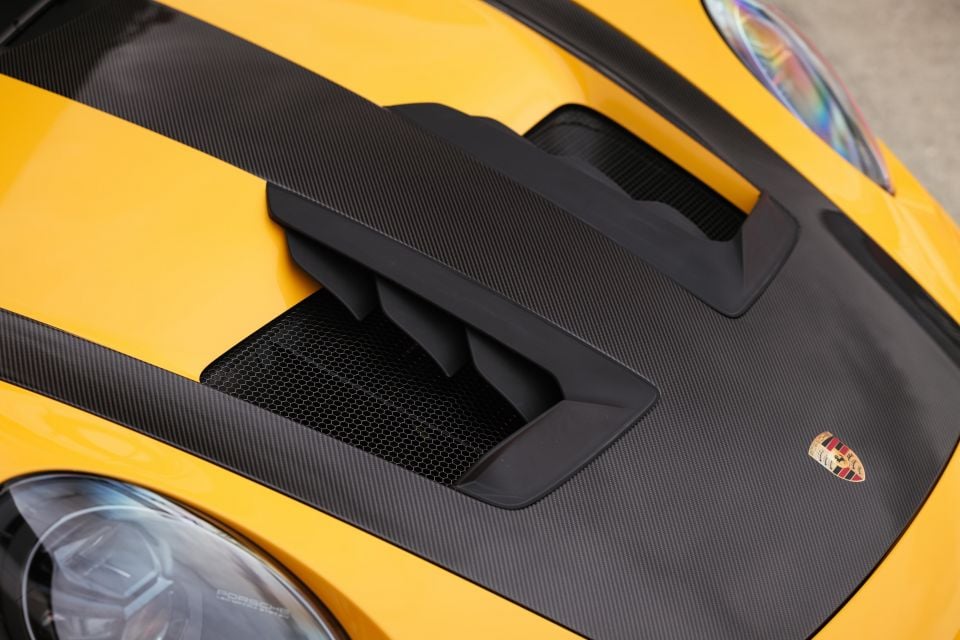
It starts with the cooling system. Porsche Motorsport aerodynamicist Mathias Roll remembers the meeting with Andreas Peuninger and 911 development chief Frank Walliser where he proposed the defining element of the engineering philosophy behind the GT3 RS. “I said to them: We need a central radiator, then we can double the downforce’,” he recalls.
What Roll was proposing was instead of the three cooling elements spread across the front of the car as in every other current 911, the GT3 RS should adopt the format of the 911 RSR race car and have a larger single radiator at mounted the centre of the car.
This would free up real estate in front of the front wheels for aerodynamic devices that would significantly increase the amount of downforce at the front axle. And with more downforce up front, Roll’s team could then create a giant, split-element rear wing while maintaining the overall aero balance of the car.
The downside was that the central radiator, the top of which is angled to the front of the car so hot air can escape through vents in front lid, would eliminate all the luggage space underneath. But Preuninger and Walliser gave Roll the green light.
The previous-generation GT3 RS generated 200kg of downforce at 200km/h and 405kg at 285km/h. At the same speeds, in high downforce mode, the new GT3 RS generates 406kg and 860kg respectively. Those are serious numbers, about the same as generated by Porsche’s Le Mans-spec 911 GTE race cars – and they’ll change forever the way you think about driving a high-performance road car on a racetrack.
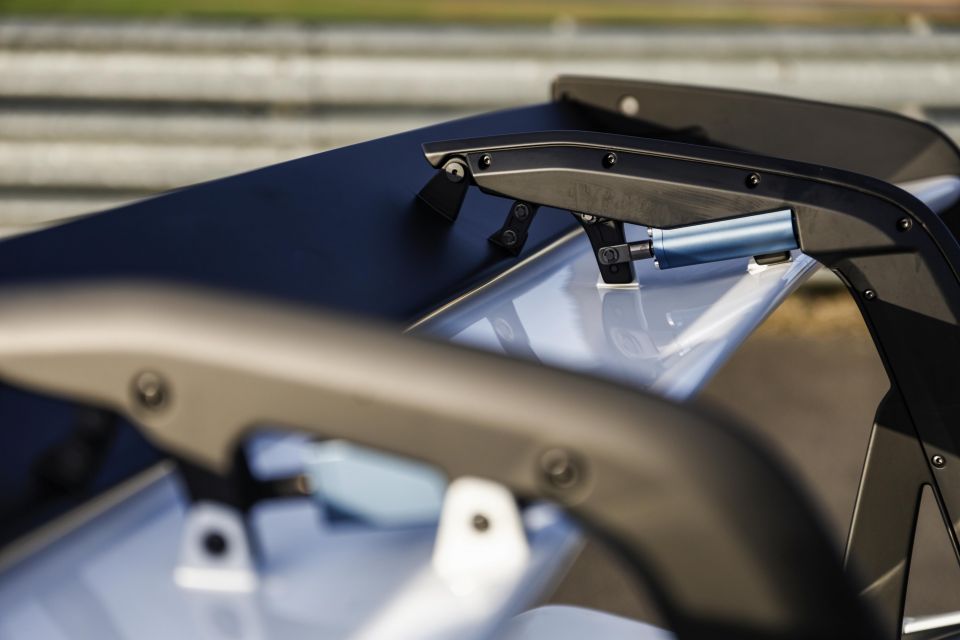

The attention to aero detail throughout is astounding. Mathias Roll says his team worked through 1500 iterations of the car’s aero setup using motorsport-spec computational fluid dynamics software, and then spent a further 250 hours honing the hardware in the wind tunnel.
Those little fins on the roof? Roll’s team found hot air exiting the radiator vents up front was washing over the roof and into engine air intakes. And as Porsche engine specialists knew, every 10-degree increase in air temperature going into the high-revving 4.0-litre flat-six decreased its output by 11kW. So, the fins were designed to direct the hot airflow down the side of the car instead.
The top element of the rear wing can flip through a 34-degree arc and will open as part of a drag reduction system that’s automatically activated at speeds over 100km/h when the accelerator pedal position exceeds 95 per cent full throttle and revs are greater than 5500rpm, providing there’s less than 0.9g lateral acceleration.
The multi-link front suspension that debuted on the 992-series GT3 was redesigned with aerodynamically shaped elements that between them contribute 40kg of downforce on the front axle. Active front flaps automatically adjust the amount of downforce acting on the front axle to maintain the car’s aerodynamic balance in concert with the drag reduction system’s variances in downforce at the rear of the car.
The underbody is fully enclosed and features no fewer than 30 fins that turn or direct air flowing underneath the car in specific directions.
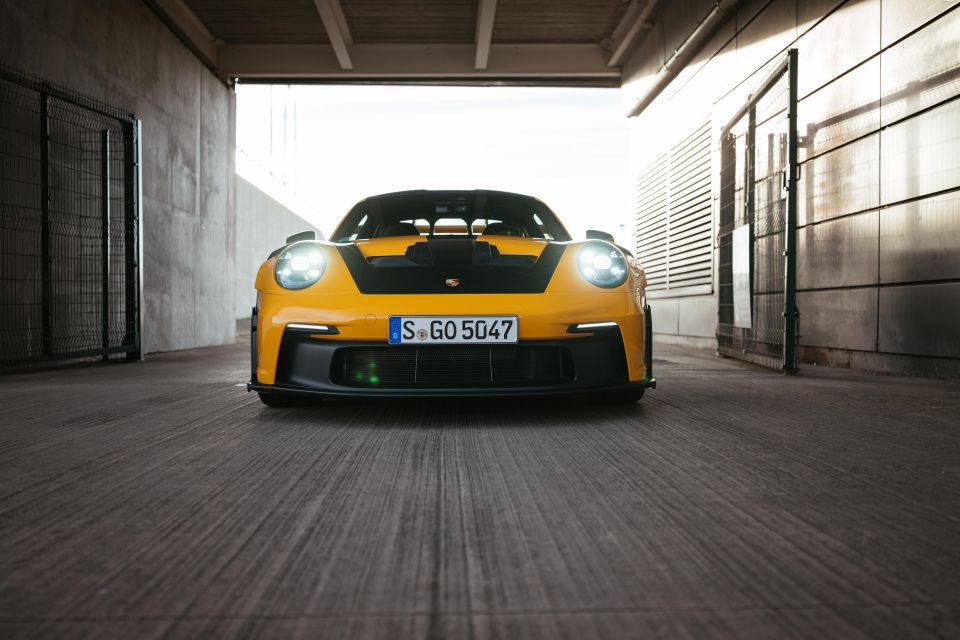
The 911 GT3 RS is available to order from $500,200 before on-road costs, with Australian deliveries commencing in the second quarter of 2023 – that’s a significant uplift from the $369, 600 charged for the regular GT3.
But such is the amount of new and re-engineered componentry in the RS, it’s not valid to consider it simply a GT3 variant. It’s pretty much a brand-new car, a standalone model that simply shares some bits with the GT3.
The GT3 RS comes in four standard colours – White, Black, Guards Red and Racing Yellow – with the choice of a further five special colours – Shark Blue, Arctic Grey, GT Silver Metallic, Python Green, and Ice Grey Metallic – available as an option.
Of course, Porsche will also paint your GT3 RS any colour you want through its paint to sample service – don’t expect much change from $30,000 if you tick that option box.

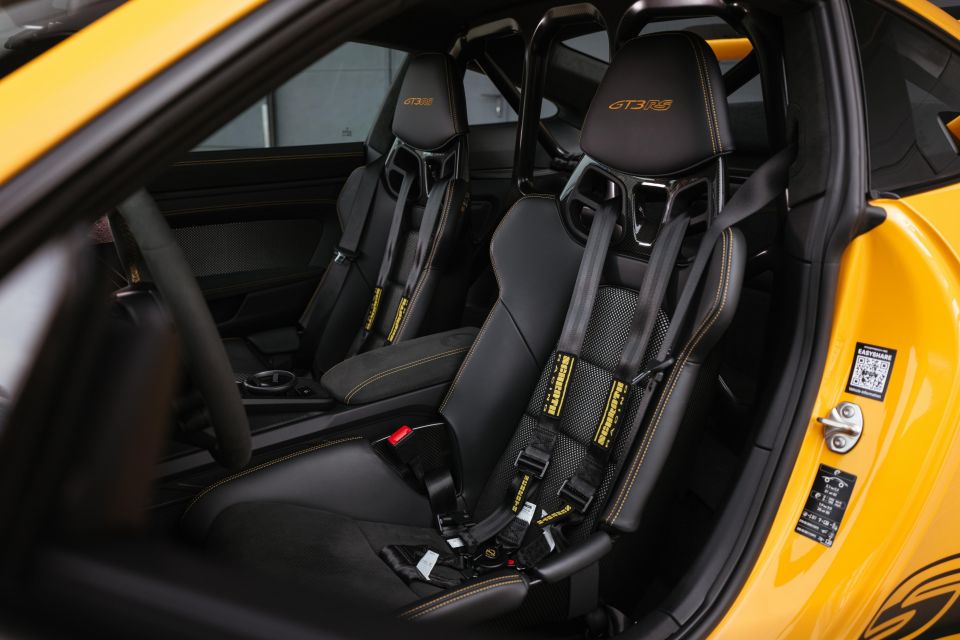
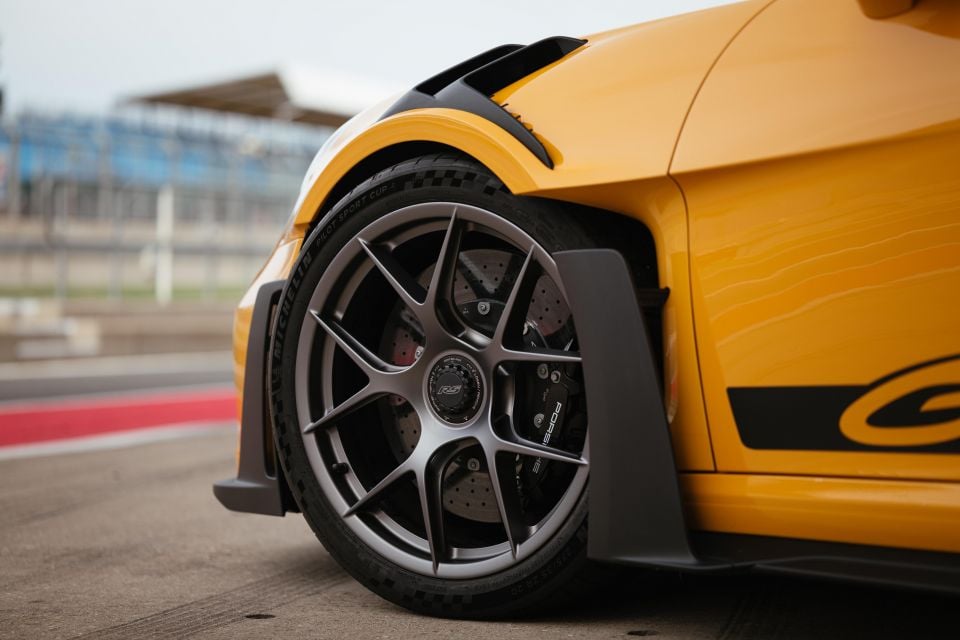
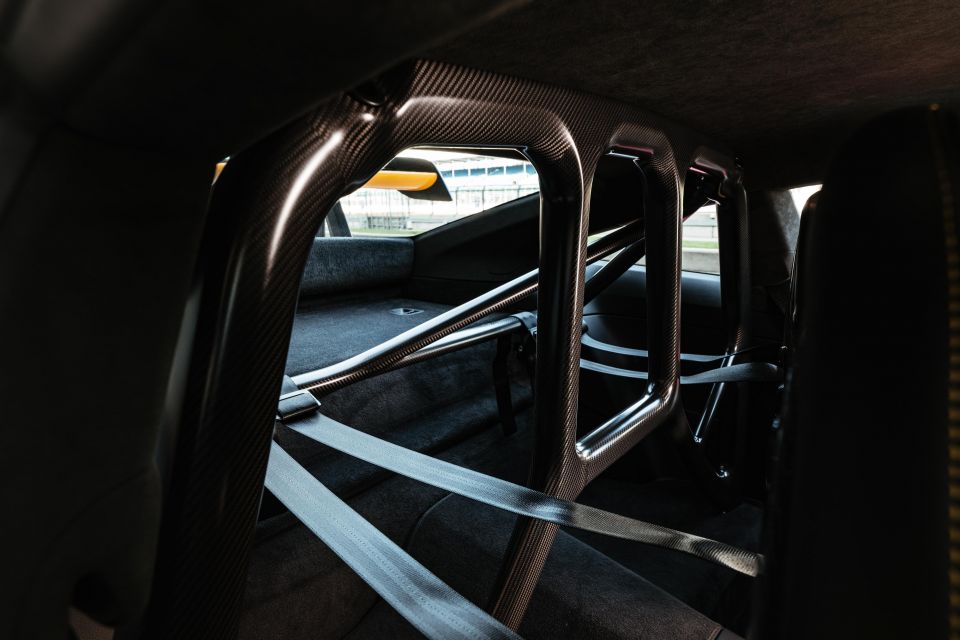
A more serious option is the $76,420 Weissach Package, distinguished by the exposed carbon weave on the front lid and the roof and the rear wing.
The more important stuff – and the stuff you’re really paying for – includes carbon-fibre reinforced plastic anti-roll bars front and rear that save 1.5kg, a carbon-fibre reinforced plastic shear panel and coupling rods at the rear of the car that saves 2kg, and magnesium alloy wheels that are 2kg each lighter than the standard aluminium alloy items.
Inside, the Weissach Package gives you magnesium paddles with race car magnet technology for greater sensitivity, six-point racing harnesses, and Porsche’s first carbon-fibre reinforced plastic roll bar for a road car, which saves 7.4kg compared with the steel item.
Overall, a Weissach Package-equipped GT3 RS weighs 1450kg, just 15kg more than a standard GT3, despite the weight added by its heavier 911 Turbo body-in-white, wider track and wider wheels, and all the hardware associated with the active aerodynamics.
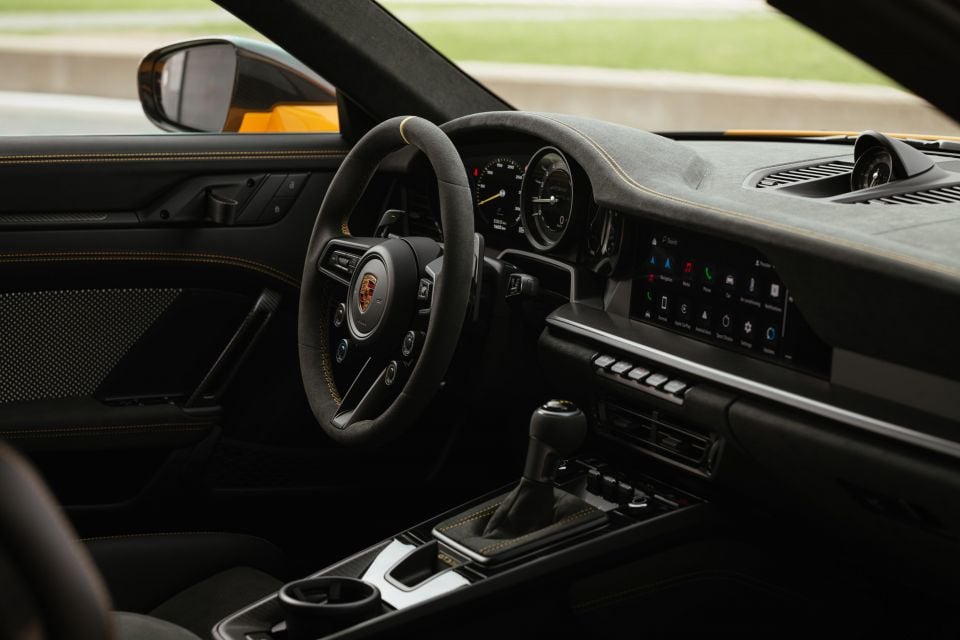
Buy your new car without the stress. It's fast, simple and completely free.

Great service from Travis and team, second time I have used this business would not hesitate to recommend them to anyone
Craig C.
Purchased a Ford Ranger in Sunshine Coast, QLD
CarExpert helped Craig save thousands on his Ford Ranger, now let us save you on your next new car.
Find a dealThe GT3 RS interior is sportier than the standard 911 cabin, though nowhere near as extravagantly so as the exterior.
Even with the optional roll cage fitted it’s nothing like a bare-bones race car cabin, with beautifully stitched leather and microfibre on the seats, doors, and dash, air conditioning, and Porsche’s impressive, large-scale, touchscreen infotainment interface.
The dash is standard Porsche fare, too, with an analogue tachometer front and centre, flanked by configurable digital screens.

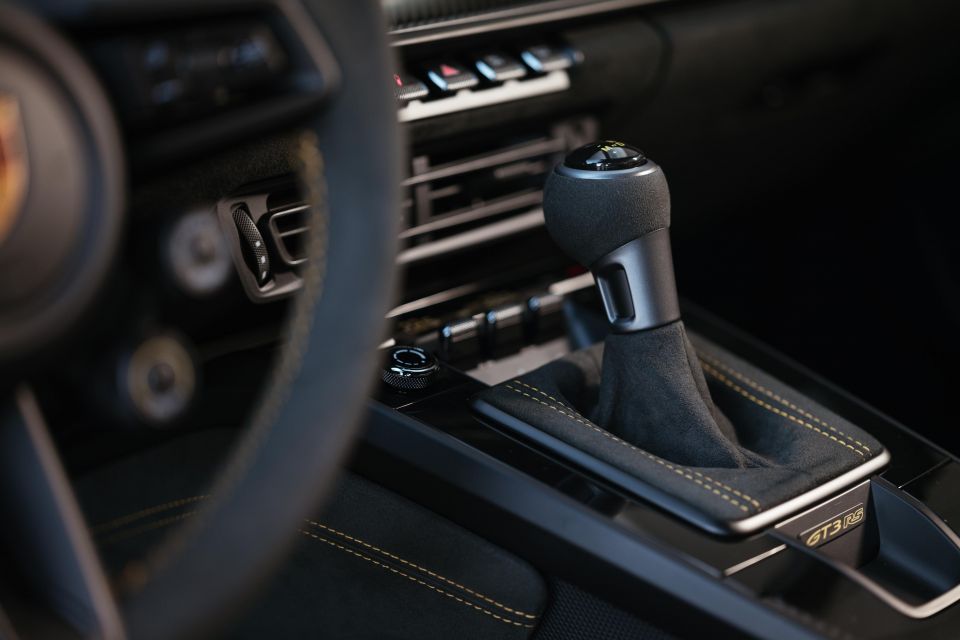
But there are subtle differences.
The PDK shifter on the centre console has no Sport Plus mode – in this car Sport Plus is the default setting for everything. Flicking the lever to the left engages manual shift mode, and that’s it.
There’s more stuff on the steering wheel, too. Four rotary dials control not only the PASM suspension settings and drive modes, but also the torque vectoring and traction control settings.

What’s remarkable it the degree to which these controls can adjust the chassis setup of the GT3 RS.
For example, the PASM controller allows you to independently change the compression and rebound rates of the dampers at the front and rear axles.
The torque vectoring system can also be adjusted to deliver different levels of torque vectoring on throttle lift-off and under power.

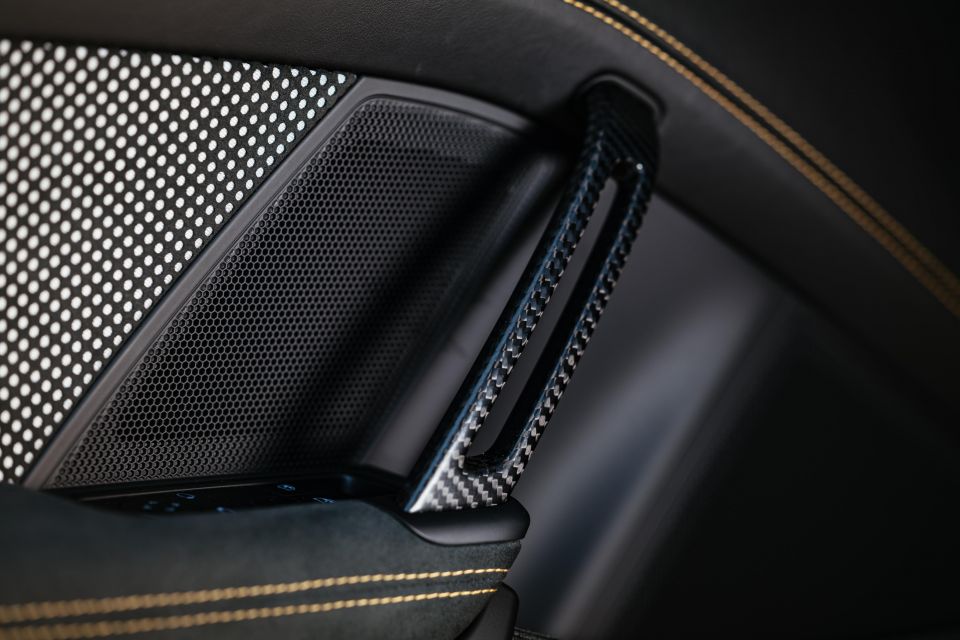

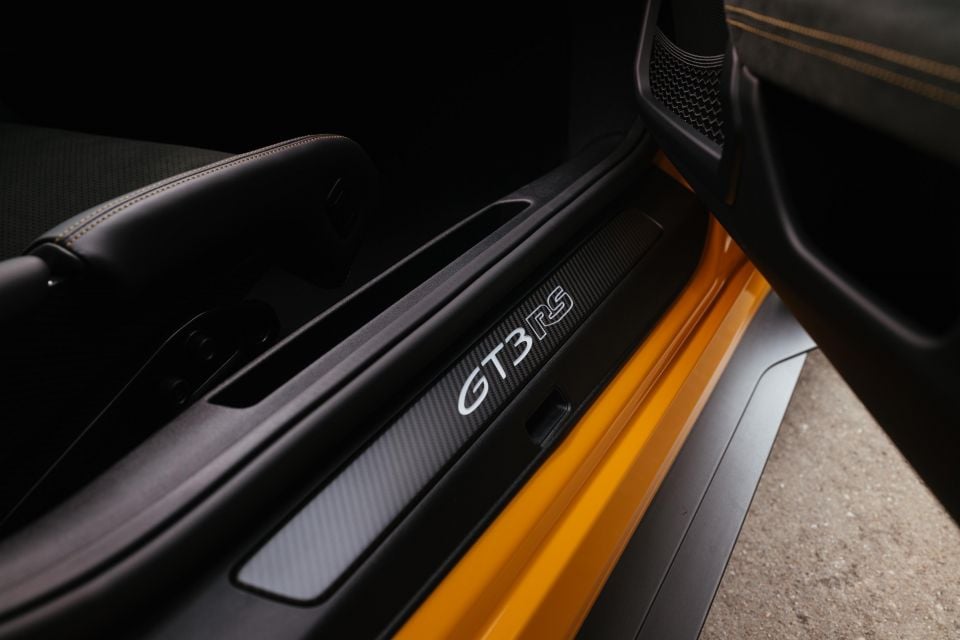
Selecting Track mode makes seven levels of traction control available. With ESC On you can switch from between level seven – maximum intervention – to level four, with four being the default mode.
Selecting ESC Dynamic keeps four as the default mode but allows you to dial up level seven if needed or dial back to level two if you trust your right foot and your reaction times. ECS Off selects level one, and leaves everything up to you.
It’s about as close to proper GT3 race car chassis tuning as you can get without resorting to mechanical ride height and roll-bar adjustments.
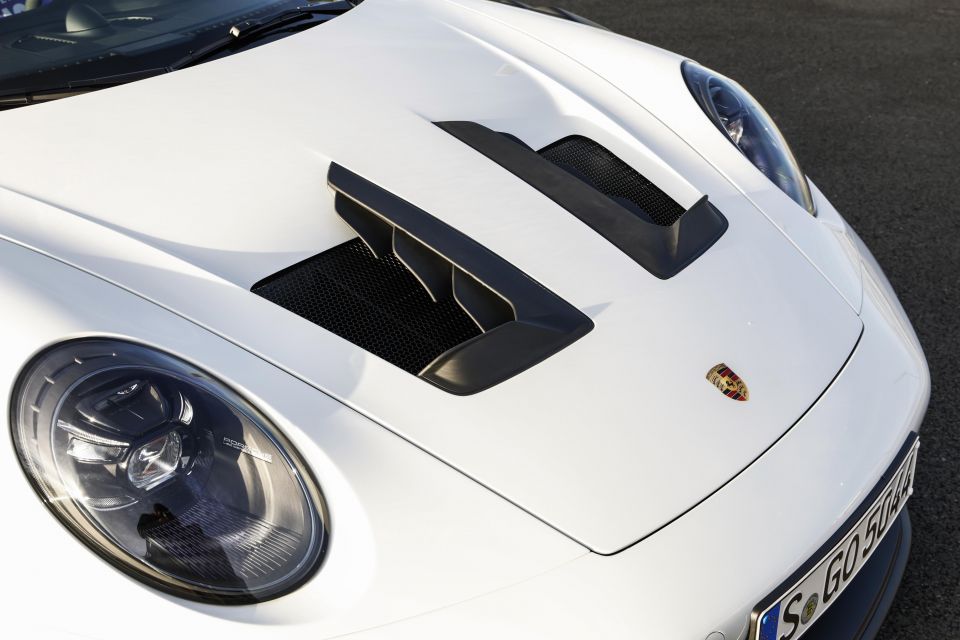
The 911 GT3 RS doesn’t have a bonnet, nor even a vestigial engine cover at the rear of the car that opens and closes as it does on other 911s – blame that giant rear wing.
If you need to top up the coolant or the oil you must open one of the flaps on either side of the car, near the base of the wing supports.
Underneath the bodywork is a slightly tweaked version of the GT3’s naturally-aspirated 4.0-litre flat-six. As in the GT3, this engine revs to 9000rpm with a glorious snarl that would sound right at home on the Mulsanne Straight at 2am. It makes 386kW, an 11kW improvement over the GT3 engine and 465Nm, which is a 5Nm drop.
Yes, the power increase is modest – it’s just 3kW more than the previous-generation GT3 RS’s peak output.

But Porsche GT Line manager Tom Wieler says, it’s taken a lot of work to unlock those few extra kW while getting the engine to meet tough EU6AP emissions control regulations.
The extra power comes courtesy of new camshafts with revised cam profiles and motorsport-derived solid cam followers, a motorsport single throttle intake system, and revised engine mapping. The cylinder heads have been reworked to ensure improved oil supply under high lateral g loads, and a new engine oil cooler delivers 20 per cent better cooling performance.
The engine drives through a revised version of the old seven-speed PDK dual-clutch transmission rather than the new eight-speed unit that made its debut with the rest of the 992-series cars.
This is because the seven-speed transmission is 20kg lighter than the eight-speed, says Tom Wieler, and the track-focused GT3 RS doesn’t need a highway-cruising eighth gear. The transmission features more tightly packed ratios, optimised lubrication, and stronger bearings, and is cooled via intakes on the underside of the car.
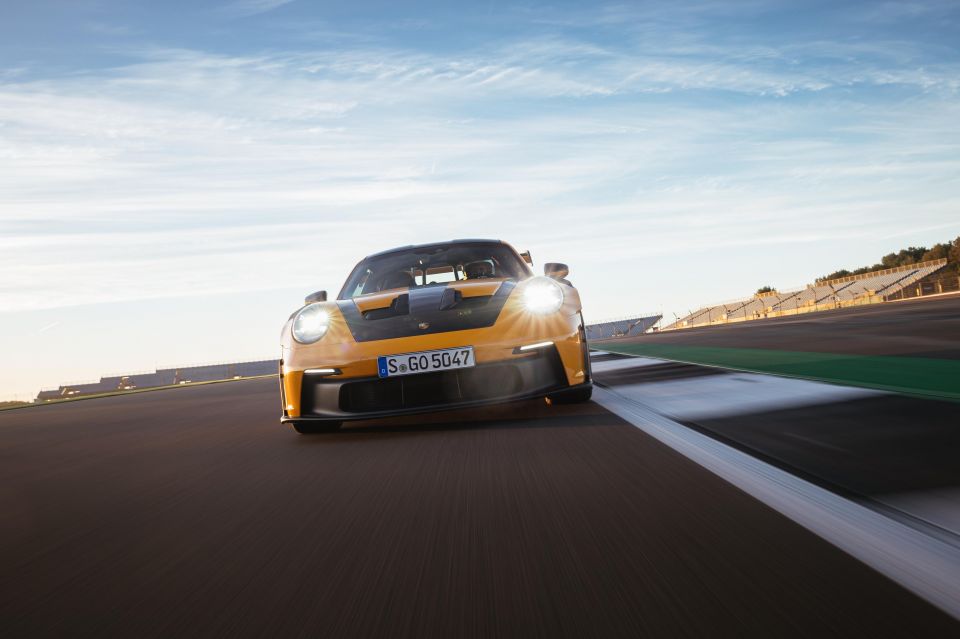
The launch venue for the GT3 RS, the 5.89km Silverstone Grand Prix Circuit, was carefully chosen for its ability to showcase the car’s astounding high-speed capability.
A handful of laps was all that was needed to prove this Porsche attacks a track like no other road-going 911. The only other road car that is as jaw-droppingly fast through high-speed corners, that will punch the air from your lungs under brakes with the same violence, is the McLaren Senna – and the McLaren costs five times more than this Porsche.
Tom Wieler says the GT3 RS will pull 2g of lateral acceleration and almost 2g under brakes. We have no reason to doubt those numbers – according to the Porsche Track Precision App, which delivers and analyses performance data to race car engineer levels of detail, we pulled a maximum of 1.44g through Silverstone’s fast and flowing corners, and 1.57g under brakes.
This in the first three laps of a track on which we’d only ever previously done a total of two flying laps in a much slower car.
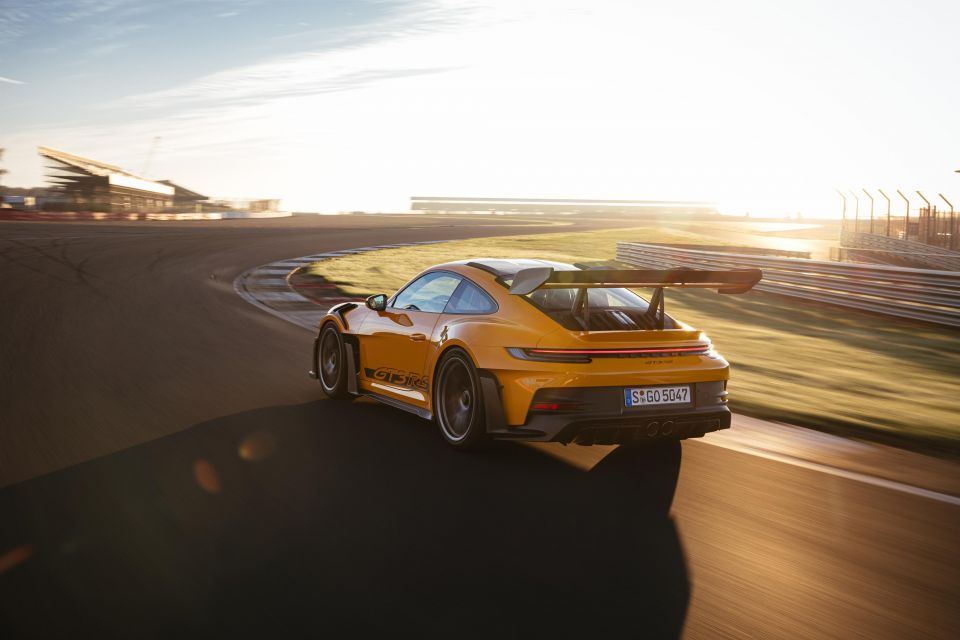
Where expert car reviews meet expert car buying – CarExpert gives you trusted advice, personalised service and real savings on your next new car.
A run at the end of the day sitting alongside Porsche hot shoe Jörg Bergmeister showed how staggeringly hard the GT3 RS could be driven.
True, Bergmeister’s car was on sticker Michelin Pilot Sport Cup 4 tyres rather than the 275/35 ZR20 front and monster 335/30 ZR 21 rear Cup 2s that are standard on the GT3 RS, but just two flying laps was enough to leave neck, torso and leg muscles aching with the effort of staying braced.
The good news is you don’t need to be Jörg Bergmeister to enjoy driving the GT3 RS as hard and fast as you dare on a track. As in the GT3, the naturally-aspirated 4.0-litre flat-six is perfectly tractable at low and medium revs, but from 5000rpm up its responses become scalpel sharp.
The steel brakes – 408mm rotors up front and 380mm at the rear – feel bulletproof.
Grenading the pedal at the end of the Wellington Straight to make the looping left-right of Brooklands and Luffield, or at the end of Hangar Straight for the tricky right-hander that is Stowe, is almost a retina-detaching moment, especially as the automatic drag reduction system slams the moveable upper element of that giant rear wing shut the moment you hit the pedal to deliver maximum downforce.
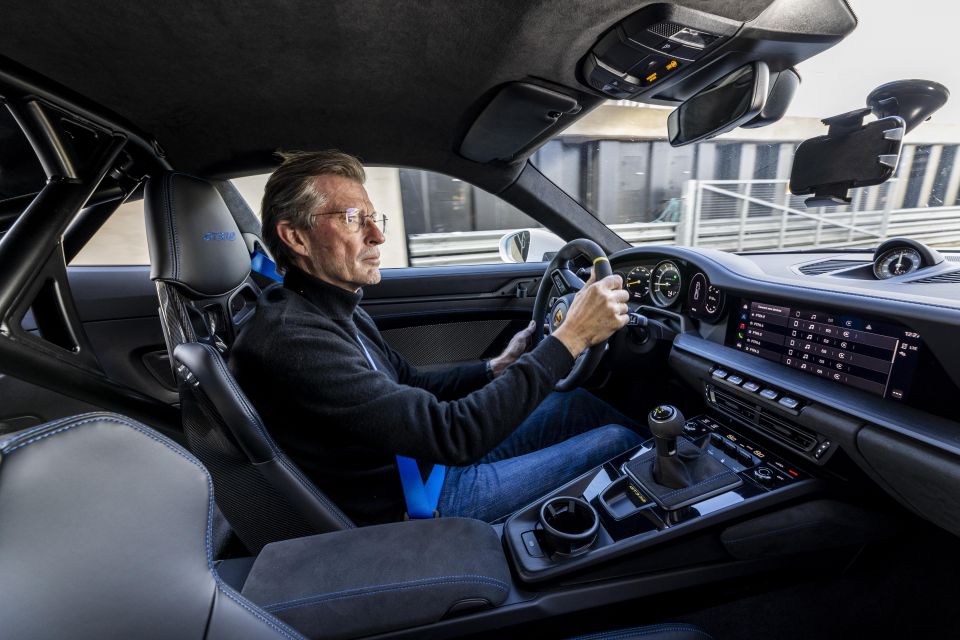
The biggest mindset shift in driving the GT3 RS is learning to trust the aerodynamic grip; understanding that even when you think you’re attacking a high-speed corner as hard as you dare, the car still has more to give – just trust it.
What’s more important, though, is the aerodynamic grip doesn’t smother the sensitivity in the chassis. Even us mere mortal drivers can clearly feel what’s going on at the front and the rear contact patches. The GT3 RS telegraphs its punches with remarkable clarity and doesn’t require the reactions of a Max Verstappen to tame it.
You notice that the most in tight, slow-speed corners, where the aero can’t work its magic.
Here the GT3 RS tells you, through your fingers and toes and the seat of your pants, exactly when you’re approaching the limits of its prodigious mechanical grip. The car’s agility and stability are enhanced by the standard four-wheel steering system.
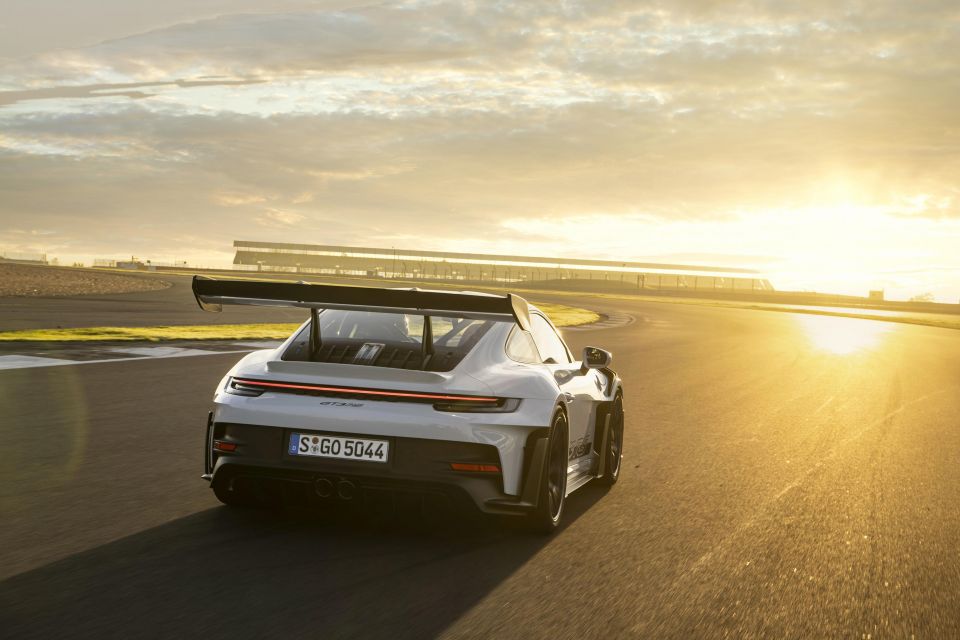
For our track sessions, the GT3 RS was set with the front and rear shock compression and rebound rates and the torque vectoring system at their default zero settings.
Every driver is different, but for a quick lap at Silverstone, Porsche pro Timo Bernhard says he clicks the front damper rebound setting to -1 and leaves the rear at its default zero setting.
He then clicks the front rebound to +2, the rear to +3. For torque vectoring, he likes +3 on the coast setting to slow the inside rear wheel and get the car turned into the tighter corners. He keeps the power setting at zero.
On the Nürburgring Nordschleife Bernhard likes the front and rear damper rebound settings at +3 and +4, respectively, while keeping the compression settings at their default zero. He also leaves the torque vectoring at the default settings.
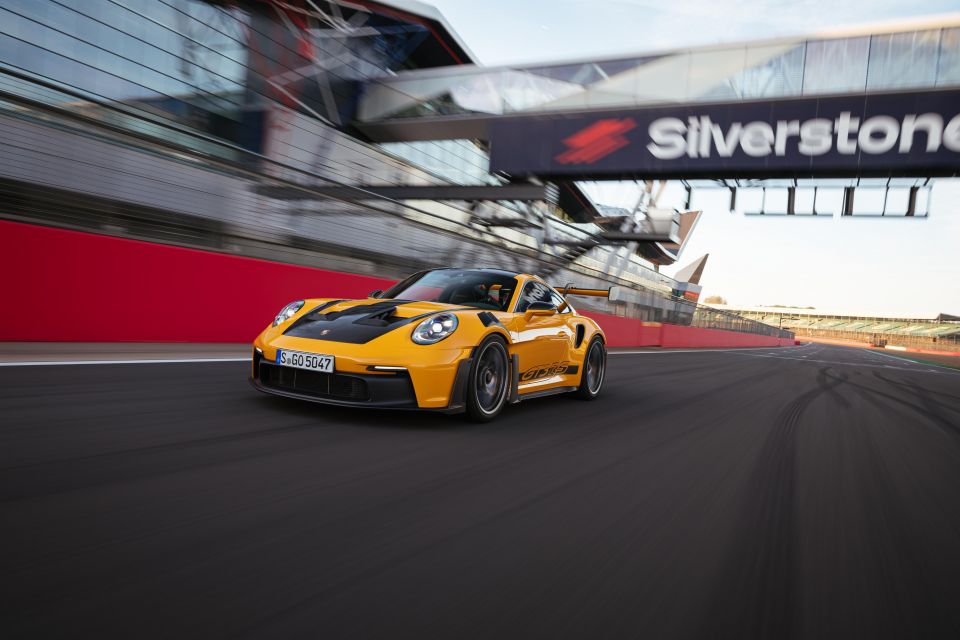
And the result? Porsche had been trying for two weeks before the launch to nail a Nordschleife lap time in the GT3 RS, but rain kept stopping play – but Tom Wieler says it will be “comfortably” in the six-minute bracket.
What’s the 911 GT3 RS like on the road? We didn’t get to find out, as all our driving was confined to the track.
But with spring rates that have been stiffened to cope with the high-speed aero loads, we suspect the GT3 RS is going to be an extreme car to drive daily in terms of the ride, not to mention the hazard the low ground clearance poses to all those fins and strakes underneath.
Does it matter? No. The 911 GT3 RS is unashamedly track focused. If you want a 911 GT3 you can happily drive every day, buy a Touring.
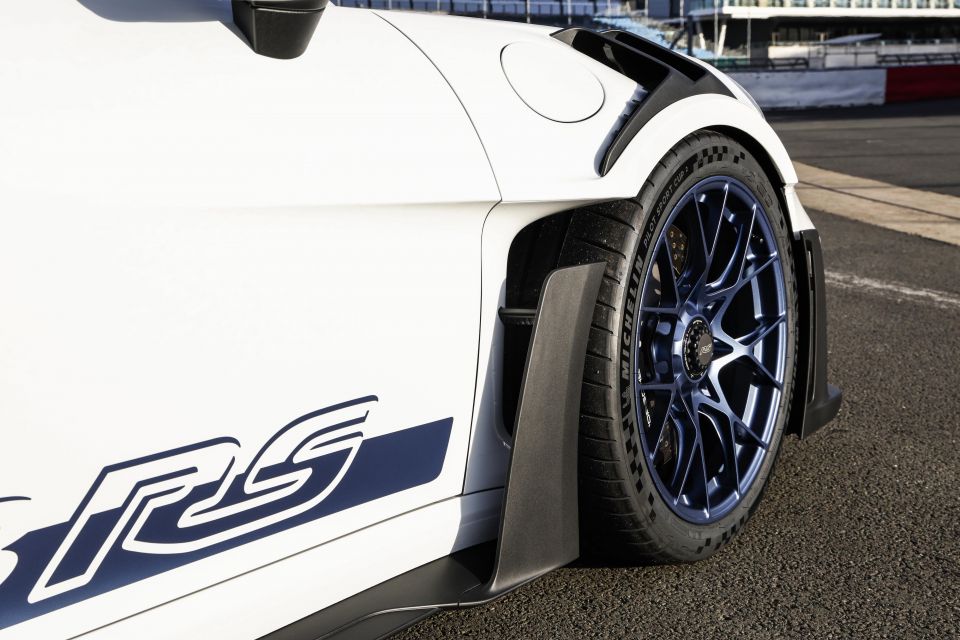
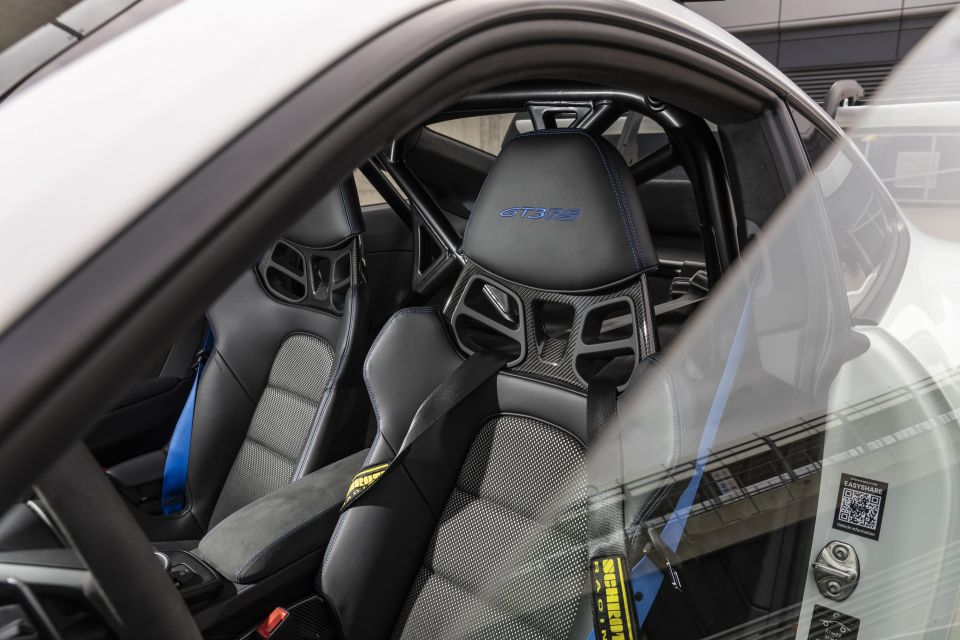
It’s more a case of what don’t you get as standard on the 911 GT3 RS, especially in terms of the go-fast gear. But it also comes standard with a surprising number of creature comforts.
911 GT3 RS highlights:
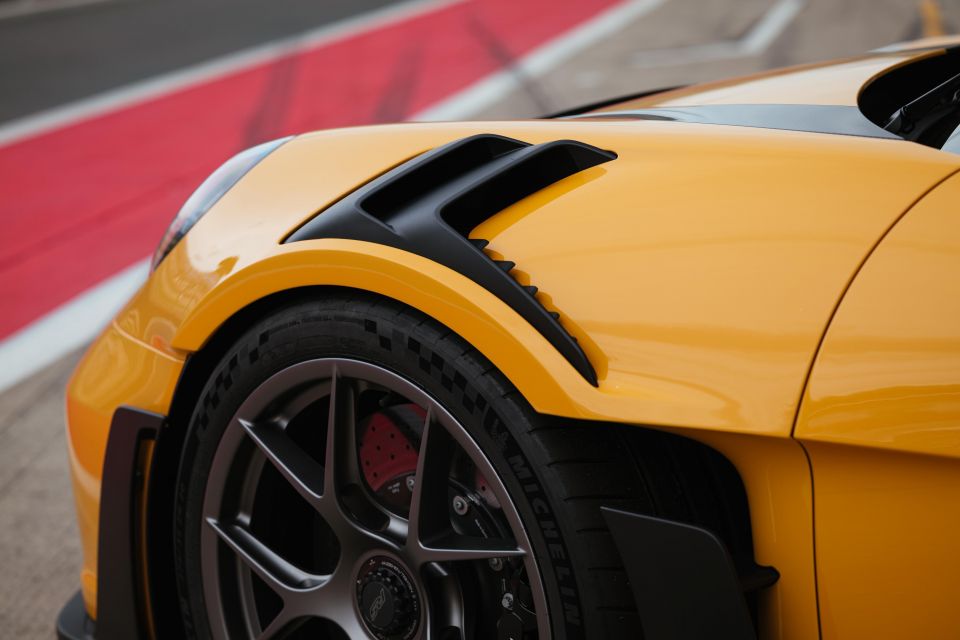
The Porsche 911 has not been crash tested by either ANCAP or Euro NCAP, and is therefore unrated.
Standard safety equipment includes:
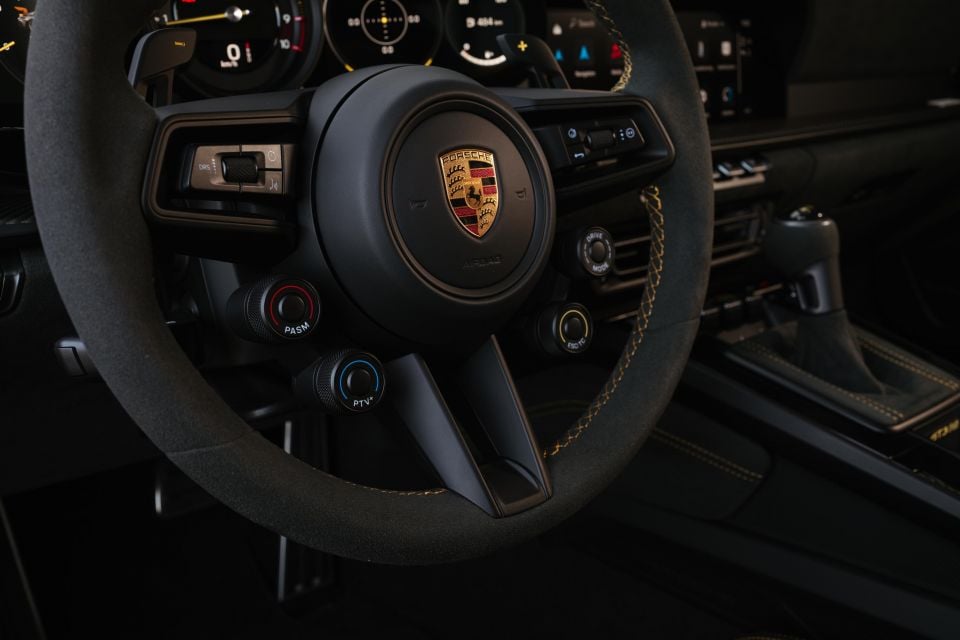
It may be the most extreme 911 you can buy, but it’s still covered by Porsche’s three-year, unlimited-kilometre warranty, as well as three-year paint warranty and 12-year rust coverage.
Service intervals are 12 months or 10,000km – whichever comes first. Pricing depends on the dealer.
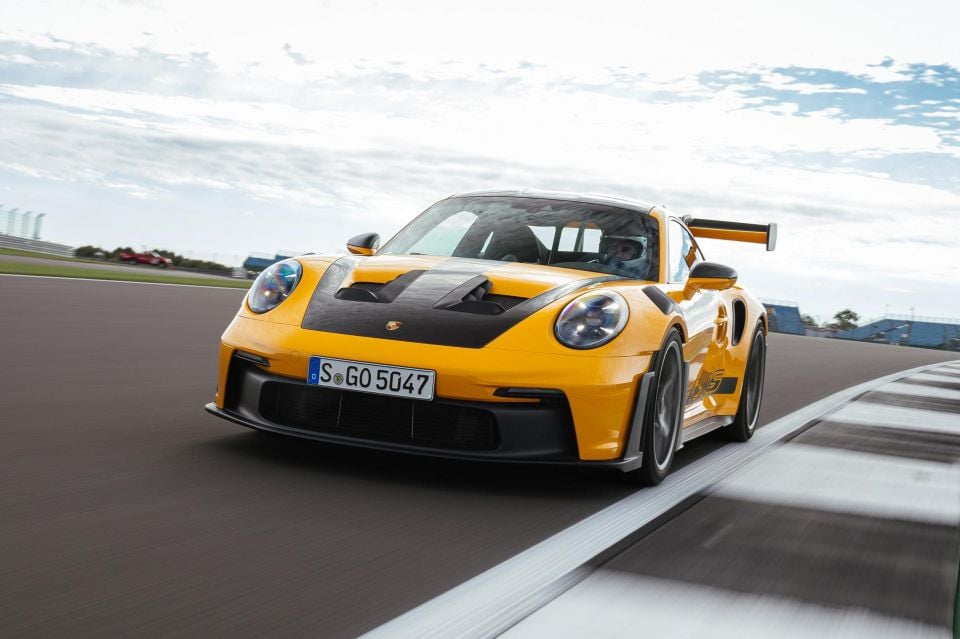
If you want the ultimate track day car; a car you can drive to a circuit and hammer around it flat out all day, then drive back home again at the end of the day, then look no further than the Porsche 911 GT3 RS. It makes you feel like a driving god.
Right now, this Porsche is arguably the best sorted factory track rat in the business, and in the context of the $800,000-odd Mercedes-AMG charged for the 28 examples of the GT Black Series it brought to Australia, or the $1.6 million-plus McLaren asked for the Senna, it’s an absolute steal.
Sure, both the Black Series and the Senna have more power, and are therefore quicker in a straight line. But there’s a fluency and a delicacy to the Porsche’s chassis the Mercedes can’t match, and a solidity and sense of robustness that’s missing from the McLaren.
What’s even more interesting is what the GT3 RS portends for the future.
In an era when almost anyone can bolt together a skateboard EV chassis with a big battery and four e-motors and create a 2000hp hypercar with brutal neck-snapping acceleration, the GT3 RS brilliantly makes the case that a great engine and a great chassis, together with light weight and high aerodynamic performance, delivers a much more satisfying driving experience.
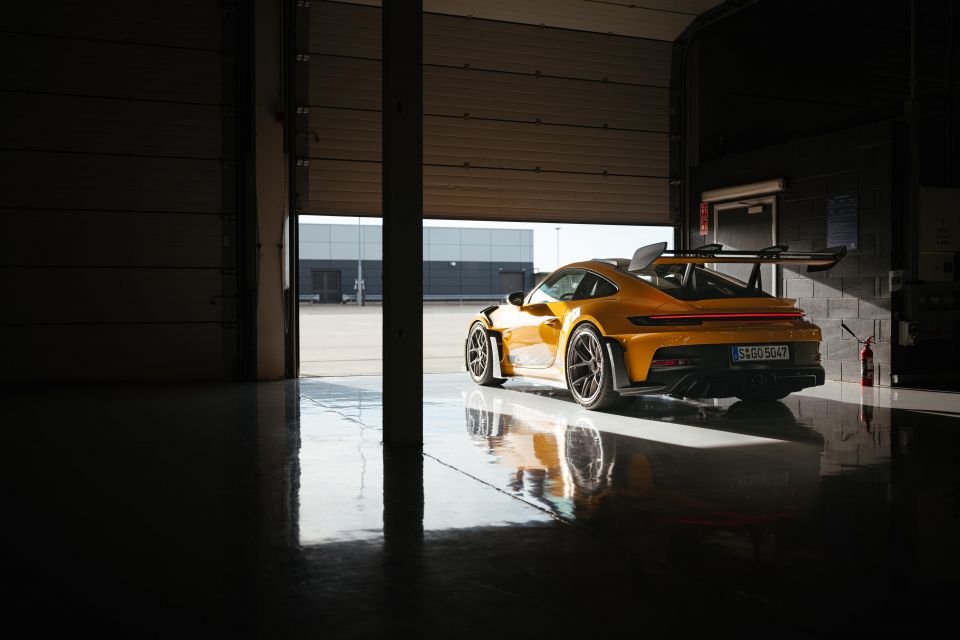
Click the images for the full gallery
MORE: 2023 Porsche 911 GT3 RS revealed, priced for Australia MORE: Everything Porsche 911
Where expert car reviews meet expert car buying – CarExpert gives you trusted advice, personalised service and real savings on your next new car.


Damion Smy
11 Hours Ago


William Stopford
2 Days Ago


CarExpert.com.au
5 Days Ago


Derek Fung
9 Days Ago
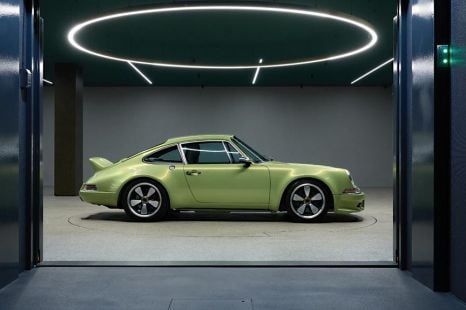

Marton Pettendy
25 Days Ago
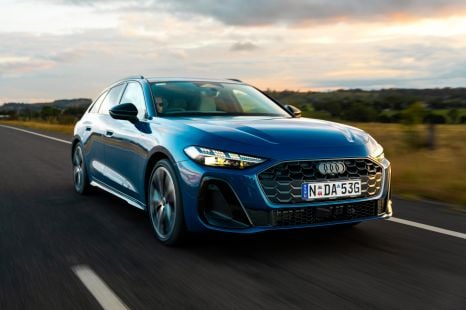

James Wong
1 Month Ago